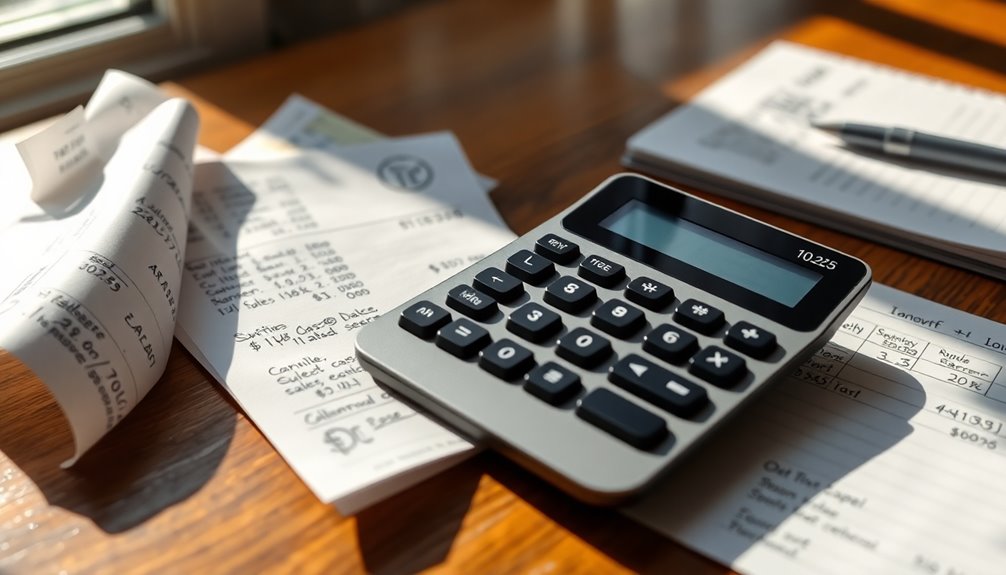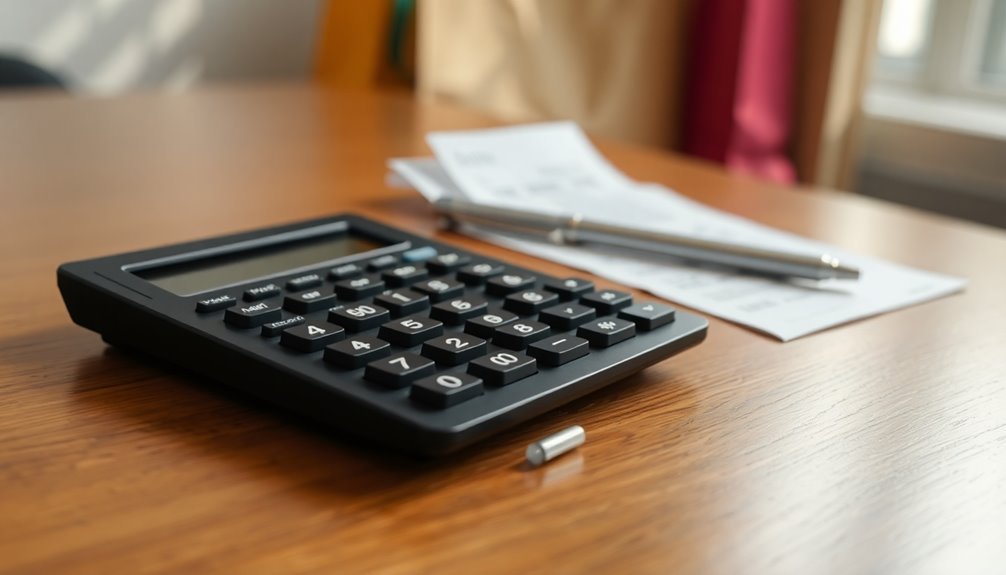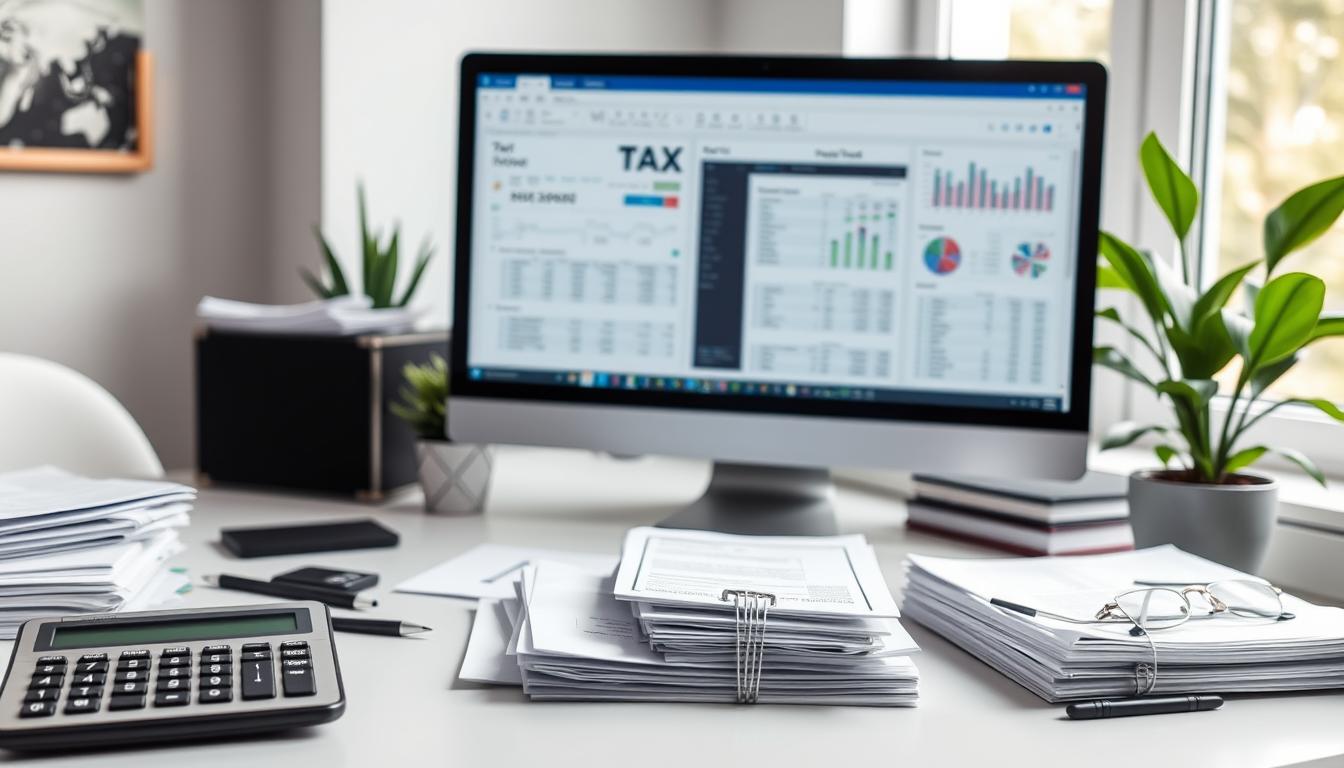To calculate taxes on a purchase, start by identifying your local sales tax rate, which you can convert into a decimal. Multiply the price of your item by this decimal to find the sales tax amount. For example, if you buy something for $70 at a 6.5% rate, your tax is about $4.55. Finally, add the sales tax to your item's price to determine the total cost. If you want to explore more techniques and tips for accurate calculations, stick around for further insights and helpful methods.
Key Takeaways
- Determine the applicable sales tax rate for your state and local area to ensure accurate calculations.
- Convert the sales tax percentage into decimal form by dividing by 100 for easier calculations.
- Multiply the item's purchase price by the sales tax rate (as a decimal) to find the sales tax amount.
- Add the calculated sales tax to the original price to determine the total price after tax.
- For reverse calculations, divide the total price by (1 + tax rate) to find the original price before tax.
Understanding Sales Tax Rates

When you're shopping, understanding sales tax rates is crucial to calculating the total cost of your purchase. Each state has its own sales tax rate, which can significantly impact your final bill. For instance, California has the highest state-level sales tax rate at 7.25%. In contrast, Colorado boasts the lowest non-zero state tax at just 2.9%.
It's also essential to consider that some states have no statewide sales tax at all, like Alaska and Delaware. However, local taxes can still apply. For example, in Alabama, local rates average around 5.29%, which can raise the total tax you pay. Retail sales taxes account for 32% of state tax collections, illustrating how vital understanding these rates is for consumers.
When you look at combined state and local sales tax rates, the differences become even clearer. Louisiana leads with an average rate of 9.56%. On the other hand, Alaska has a surprisingly low combined rate of 1.82%.
Understanding these nuances can help you anticipate costs and budget more effectively. Before you make a purchase, check the specific rates in your state and locality to avoid surprises at checkout. Knowing what to expect makes shopping a smoother experience.
Calculating Sales Tax Amount

Calculating the sales tax amount is a straightforward process that ensures you know exactly how much you'll pay at checkout. To start, you need to convert the sales tax percentage into a decimal. Just divide the percentage by 100; for example, 6.5% becomes 0.065. This decimal is essential for accurate calculations.
Next, take the price of the item before tax and multiply it by the sales tax rate as a decimal. If your item costs $70, you'd calculate $70 multiplied by 0.065, which equals $4.55. This step is crucial for determining the total tax owed, whether you're buying a single item or multiple items in one transaction. In most cases, sales tax is imposed on the sale of goods and services by states.
Remember to round the sales tax amount to two decimal places for accuracy. Different tax calculation methods may apply, depending on whether the sales tax is based on the gross or net amount.
However, for most purchases, simply multiplying the item price by the tax decimal will give you the correct sales tax amount. This clear approach helps you stay informed about your expenses before finalizing your purchase.
Determining Total Price After Tax

Understanding the total price after tax is essential for budgeting your purchases effectively. To determine this total, start by identifying the purchase price of the item. Make sure no other fees or taxes are included in that price.
Next, convert the sales tax rate into decimal format by dividing it by 100.
Now, you can calculate the sales tax amount. Multiply the net price by the tax rate in decimal form. For example, if you're buying an item priced at $55 with a 7.37% tax rate, calculate the sales tax as $55 * 0.0737, which equals $4.05. This is important because sales tax rates can vary significantly from state to state.
Once you have the sales tax, add it to the net price. In our example, you'd find the total price by adding $55 and $4.05, resulting in a total of $59.05. If there are any duties, ensure they're factored into the net price before calculating the sales tax.
Finally, remember to round all calculations to the nearest cent for accuracy. By following these steps, you'll know exactly how much to budget for your purchase, making your shopping experience smoother and more predictable.
Reverse Calculating Sales Tax

Sometimes, you might find yourself needing to determine the original price of an item after tax has been added. To do this, you'll want to use a reverse sales tax formula. Start by identifying the total price you paid and the applicable tax rate. Make sure to convert the tax rate into a decimal by dividing it by 100.
You can then apply the formula: Total Price / (1 + Tax Rate) = Original Price. For example, if you paid $106 and the tax rate is 6%, you'd calculate it as $106 / 1.06, which gives you an original price of $100.
If the total price you paid was $107 with a 7% tax rate, you'd use $107 / 1.07 to find the same original price of $100. Additionally, understanding the sales tax calculation helps ensure accurate financial planning.
Once you've found the original price, you can easily determine the sales tax amount by subtracting this original price from the total price. In our examples, that means $106 – $100 equals $6 in sales tax.
Using this reverse calculation method can help you understand the cost before taxes and clarify your expenses.
Tips for Accurate Calculations

Accurate calculations are crucial when determining taxes on purchases to avoid any financial surprises. Start by identifying the sales tax rate for your location and convert that percentage into a decimal. For example, a 6.5% tax rate becomes 0.065. Don't forget to check for any additional taxes or duties that may apply.
Next, calculate the sales tax by multiplying the purchase price by the tax rate in decimal form. Round this amount to the nearest cent for accuracy. If you're buying multiple items with varying tax rates, calculate each item's tax separately. Additionally, using the cumulative calculation method can help ensure that your tax withholdings are accurate over time.
Once you have the sales tax amount, add it to the original price to find the total cost. Make sure to include all applicable taxes and fees, applying them in the correct order.
To avoid mistakes, double-check your calculations. Document everything for future reference, especially if your purchases are complex.
If you find yourself in a tricky situation, don't hesitate to consult tax guidelines or seek professional help to ensure your calculations are accurate and compliant. Remember, staying informed about tax rates can save you from unexpected costs later on!
Frequently Asked Questions
What Are the Different Types of Sales Tax?
When you're looking at sales tax, you'll find several types.
There's the state sales tax, which varies by state, like California's high rate of 7.25%. Some areas also have local sales taxes that can add to your total.
Combined sales tax includes both state and local rates.
Special rates apply to certain items, like fuel or food, and these can get complex, depending on local rules and exemptions.
How Do Tax Exemptions Work for Certain Purchases?
Tax exemptions work by allowing certain purchases to be free from sales tax or taxed at a lower rate.
You'll find that items like food, clothing, and essential medical devices often qualify for these exemptions.
Additionally, purchases made by government agencies or nonprofit organizations are typically exempt.
To claim an exemption, you must provide a completed exemption certificate to the seller, ensuring compliance with the law and avoiding unnecessary tax expenses.
Can I Get a Refund on Sales Tax?
Yes, you can get a refund on sales tax if you've overpaid or made a purchase in error.
To claim your refund, you'll need to use the appropriate form and submit supporting documents, like receipts. Log into your state tax portal to follow the refund request steps.
If you're a business, you can also claim a credit on your sales tax return. Make sure to check specific requirements for your situation!
Do Online Purchases Incur Sales Tax?
Yes, online purchases can incur sales tax, depending on where you live and where the seller is located.
Most states require sales tax collection if the business has a physical presence or meets certain sales thresholds in your state.
Marketplace platforms like Amazon and eBay often handle this for you.
It's essential to check your state's regulations, as some states, like Delaware and Montana, don't charge sales tax on online purchases.
How Often Do Sales Tax Rates Change?
Sales tax rates can change quite frequently, sometimes every six months, depending on where you live.
For instance, in Colorado, rates shift on January 1st and July 1st, while in New York, local rates can change four times a year.
These adjustments aim to keep things predictable, and you'll usually get advance notice.
Conclusion
Now that you know how to calculate taxes on a purchase, you can confidently handle your transactions. By understanding sales tax rates and knowing how to compute the total price after tax, you'll avoid any surprises at checkout. Remember, you can even reverse calculate to figure out the original price before tax if needed. With these tips, you'll make accurate calculations every time, ensuring you stay informed and in control of your spending. Happy shopping!








